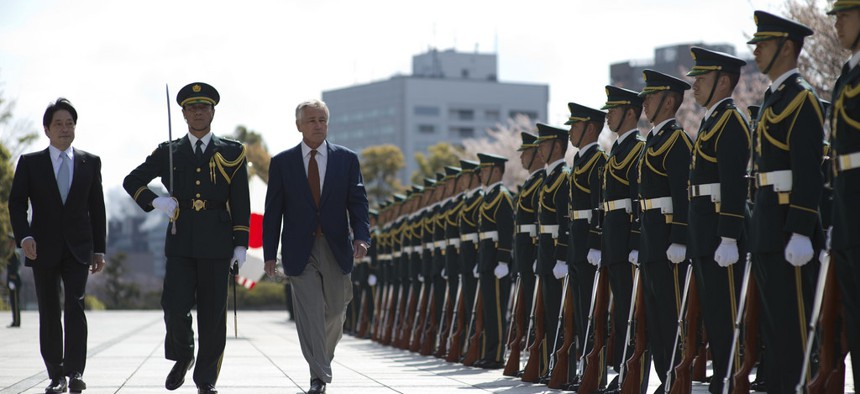
Dod photo by Erin A. Kirk-Cuomo
3 Myths About the Pivot to Asia
There has been much debate – and much misunderstanding – about the purpose and function of the so-called ‘pivot’ to Asia. By Janine Davidson
Since President Obama announced his intention to “rebalance” foreign policy attention toward the Asia-Pacific region, there has been much debate – and much misunderstanding – about the purpose and function of this shift. As elements of the rebalance begin to fall into place, this conversation will only grow louder.
As the Deputy Assistant Secretary of Defense for Plans from 2009 to 2012, I was responsible for developing the military elements of this policy and recommending changes to our military posture to support the president’s strategy. Having left government almost two years ago, I’m still amused to note how misunderstood the strategy is. I’d like to clear up three of the most common misconceptions and myths about the policy:
Myth #1: The So-Called “Pivot”
The first misconception is a word itself – “pivot” – which implies that we’re pivoting awayfrom someplace in order to pay more attention to Asia. This is usually what worries our European allies the most. But in reality, no military units were moved from Europe to Asia because the U.S. is not pivoting away from our long-time allies. It is rebalancing its diplomatic, economic, and strategic focus following a decade of war.
Since late 2001, militarily, troops, planes, ships and intelligence assets – those based in the continental United States, Europe, and Asia – had been overwhelmingly engaged in Iraq and Afghanistan. Even Marine Corps units and some Army troops, traditionally stationed in Japan and Korea, have seen frequent rotations in Iraq and Afghanistan. Indeed, two out of the four brigade combat teams stationed in Europe have been perpetually deployed to the warzones.
Thus, as these two wars wind down, these military forces are going home, which in the case of some Marines has meant Okinawa, and some Army units, Germany. More resources, diplomatic energy, and White House attention have become available to focus on longer-term opportunities. Given the global economic and demographic shifts now taking place, this means the need for a rebalance (not pivot) to Asia.
Myth #2: The Rebalance Is All About Containing China
While the U.S. has been fighting wars, other parts of the world – Asia in particular – have continued to rapidly transform. With the world’s fastest growing economies in Asia and the vast amounts of global trade moving through the Asia-Pacific region, the importance of Asia to America’s future has only become clearer. While China is clearly the growing regional power, other issues, such as the threat of North Korea, the proliferation of weapons of mass destruction, terrorism, piracy, and increased threat of natural disasters, all endanger the stability of the region and – by extension – global trade.
From a military posture perspective, the U.S. needs to stay engaged not by projecting power from the homeland, but by physically being positioned forward alongside partners and allies. The military is attempting to catalyze multilateral cooperation on shared security threats, such as piracy or freedom of navigation, by creating the institutional and in some cases physical infrastructure through which other nations could engage. Military-to-military engagement also enhances interoperability and promotes shared norms for civilian control over the military, respect for human rights, and general military professionalism. This is intended to have a positive, cascading effect on regional stability.
In nearly all of these activities, the U.S. has welcomed China’s participation. China has been encouraged to join multilateral efforts and to help craft regional rules of engagement to promote the peaceful resolution of the inevitable differences and potential disputes that might arise.
Myth #3: The Rebalance Is Just About The Military
For all the attention paid to military issues, the actual changes in U.S. military posture are only one element of the overall rebalance. These activities support the primary efforts, which focus on diplomacy, trade and economic development. As Kurt Campbell, former U.S. Assistant Secretary of State for Asia, repeatedly explained, U.S. diplomatic and economic leadership requires sustained engagement in multilateral institutions and bi-lateral dialogue.
The heart of the rebalance is the “scores of bilateral and multilateral meetings” meant to build and sustain new and old relationships and promote economic development in the region (signaled most recently by the first-ever U.S. hosted meeting of ASEAN). These engagements may be less visible than U.S. Marines conducting exercises with Australians in Darwin or U.S. Navy Littoral Combat ships rotating through Singapore, but they are the real key to continued U.S. leadership in the region.
The U.S. has underwritten the security, stability, and historic economic growth in the Asia-Pacific for over seventy years. Americans – from the boardrooms to the Congress and the White House – understand that America’s future depends on a stable and vibrant Asia. This self-interest is reflected in the diplomatic, economic, and military elements of the Asia rebalance. It’s also a firm guarantee that the U.S. will continue to play a critical role in a peaceful and prosperous Asia.
This post appears courtesy of CFR.org.
